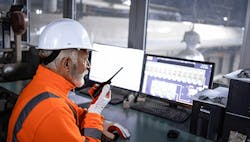Data availability raises the bar on application expectations
Brian Parsonnet is chief technology officer at Seeq.
What have been the biggest improvements to industrial-networking/data-analytics technology in the past five years?
Brian Parsonnet, chief technology officer, Seeq: The biggest improvement is not technical; it’s vision. The growth of sensors and remote access in our personal lives has been explosive—from doorbells to air tags, Wi-Fi lighting, automobile black boxes and smartphone features like “find my friends.” Our acceptance of these and other technologies compels us to adopt a similar approach in our work environments, setting new expectations for what can be achieved and how it creates value.
Also read: Are big data errors throwing off your analytics?
How has industrial-networking/data-analytics technology benefitted from remote monitoring and connectivity?
Brian Parsonnet, chief technology officer, Seeq: Without question, remote monitoring and connectivity have improved day-to-day operations for manufacturers. Industrial manufacturing sites are critically sensed for control, but under-sensed and under-staffed for monitoring purposes. Additionally, process expertise is now frequently distributed among off-site workers, service vendors and even equipment manufacturers themselves. This has driven huge growth in sensors and remote-monitoring technologies, reducing some of the needs of a control system, creating new markets and business models.
Can you explain how software development has changed industrial-networking/data-analytics technology design and production?
Brian Parsonnet, chief technology officer, Seeq: The big hitters are increased remote or distributed development teams, more open-source repositories for machine learning and enhanced infrastructure platform capabilities, including data storage, communications and user interfaces. This has greatly reduced cost, increased development speed, improved innovation and enabled technology crossover between vertical markets.
When will industrial-networking/data-analytics technology become IT-friendly enough that engineers are no longer required for installation and operation?
Brian Parsonnet, chief technology officer, Seeq: This is a big arena, and the industry structure, standards, value proposition, infrastructure, cost and return on investment (ROI) are all still moving quickly. Meanwhile, significant technical issues regarding security, performance, safety and intellectual-property (IP) protection limit the speed of adoption and growth. Self-service industrial-networking/data-analytics technology is going to be enormous and successful, but it will take at least another decade to sufficiently solve these technical issues.
Tell us about your company’s state-of-the-art industrial-networking/data-analytics technology.
Brian Parsonnet, chief technology officer, Seeq: As operational data volume increases, many manufacturing organizations are data-rich and information-poor (DRIP) due to the gap between data availability and analytics capabilities. Seeq closes this innovation gap with a new generation of software that enables faster insights and decision-making by manufacturing employees.
Seeq is an advanced analytics solution for process manufacturing data that enables organizations to rapidly discover, share and scale analyses across assets and plants. Oil and gas, pharmaceutical, specialty chemical and numerous other vertical industries rely on Seeq to improve production outcomes, including yield, margins, quality and sustainability.
Mike Bacidore is the editor in chief for Control Design magazine. He is an award-winning columnist, earning a Gold Regional Award and a Silver National Award from the American Society of Business Publication Editors. Email him at [email protected].
About the Author
Mike Bacidore
Editor in Chief
Mike Bacidore is chief editor of Control Design and has been an integral part of the Endeavor Business Media editorial team since 2007. Previously, he was editorial director at Hughes Communications and a portfolio manager of the human resources and labor law areas at Wolters Kluwer. Bacidore holds a BA from the University of Illinois and an MBA from Lake Forest Graduate School of Management. He is an award-winning columnist, earning multiple regional and national awards from the American Society of Business Publication Editors. He may be reached at [email protected]

Leaders relevant to this article:


